The idea behind the Honig rule broach is fairly straightforward. A ruled form consists of horizontal and vertical lines. Setting this using conventional rule is tedious. Casting machine makers had various solutions (see the Ruleform Composition the Economical Ludlow Way or Mergenthaler Linotype's Rogers Tabular Matrices (312.67 (January, 1925)) .
The Honig represented a solution which used ordinary rule (continuously cast since the introduction of the Elrod) and hand methods. The rule was used for the lines in one direction (say, the horizontal). Each rule was broached with a little slot into which a triangular brass rod could be slipped. These gave the other direction (say, the vertical).
It is no surprise that the maker of the Honig, the Univeral Mono-Tabular Corporation, later introduced a competitor to the Elrod (the Universal Strip Caster).
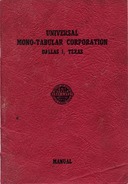
Manual
Universal Mono-Tabular Corporation[:] Manual [title on cover] The Mono-Tabular Broach and Cabinet [title on first page] Instruction manual. Part drawings for Punch, linecaster Matrix ("Matrice"), and linecaster Rule Slides. Ad for the Honig Rule Cutter. Ad for the Universal Strip Caster.
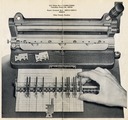
[Illustration]
This is a single scan of the two-page spread at the center of the Manual.
The icon at left links to a 2048 pixel wide version of this image (which is reduced in size from the original scan. Here is the original scan (a 600dpi RGB PNG image, which is 65 Megabytes in size): universal-mono-tabular-broach-manual-0600rgb-010-011-fullspread-rot90cw.png
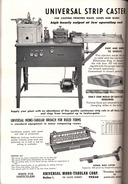
Inland Printer. Vol. 124, No. 3 (December, 1949)
Inland Printer. Vol. 124, No. 3 (December, 1949): 96.

Inland Printer. Vol. 134, No. 3 (December, 1954)
Inland Printer. Vol. 134, No. 3 (December, 1954): 159.
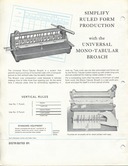
Lanston Monotype GADS Ad.
The Universal Strip Caster (recto) and Simplify Ruled Form Production with the Universal Mono-Tabular Broach. A sale flyer by Graphic Arts Dealer Services, a division of the Lanston Monotype Company. (The icon here shows page 2 of the flyer; the PDF contains both pages.)

US 2,153,890. Honig. Tabular Broaching Machine
US patent 2,153,890. Filed 1937-07-12 as application s/n 153,240. Issued 1939-04-11. Henry T. Honig. "Tabular Broaching Machine." Assigned to Univeral Monotabular Corporation.
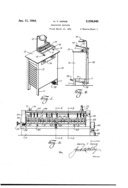
US 2,338,940. Honig. Broaching Machine
US patent 2,338,940 Filed 1941-03-10 as application s/n 382,479. Issued 1941-06-11. Henry T. Honig. "Broaching Machine." Not assigned, but the Universal Mono-Tabular Corp. Manual cites it as licensed.

US 1,682,514. Hollister & Chapman.
US patent 1,682,514. Filed 1925-03-07 as application s/n 13,734. Issued 1928-08-28. William C. Hollister and Leo M. Chapman. "Means and Method for Producing Vertically-Ruled Printing Forms." This patent includes the use of a linecaster matrix. Assigned to Chicago Lino-Tabler Company. The Universal Mono-Tabular Corp. Manual cites it as licensed.
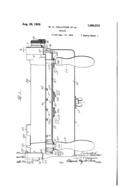
US 1,682,515. Hollister & Chapman.
US patent 1,682,515. Filed 1926-09-23 as application s/n 137,321. Issued 1928-08-28. William C. Hollister and Leo M. Chapman. "Means and Method for Producing Vertically-Ruled Printing Forms." Assigned to Chicago Lino-Tabler Company. The Universal Mono-Tabular Corp. Manual cites it as licensed.
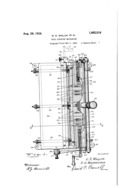
US 1,682,516. Wallin & Masengarb
US patent 1,682,516. Filed 1923-05-02 as application s/n 636,106; filing renewed 1927-04-04. Issued 1928-08-28. Gustaf F. Wallin and Emil G. Masengarb. "Rule-Punching Mechanism." Assigned to Chicago Lino-Tabler Company. The Universal Mono-Tabular Corp. Manual cites it as licensed.
The numbers of The Inland Printer from which extracts are reprinted here were copyright at the time of their publication, but a search of the copyright records reveals no renewal as would then have been required. They therefore passed into the public domain upon the expiration of their original copyright. The digital versions here remain in the public domain.
The Graphic Arts Dealer Services / Lanston Monotype Company advertising brochure reprinted here was published in the US without copyright notice at a time when such notice was required to secure copyright. It therefore passed into the public domain upon initial publication. The digital reprint of it here remains in the public domain.
All portions of this document not noted otherwise are Copyright © 2010 by David M. MacMillan and Rollande Krandall.
Circuitous Root is a Registered Trademark of David M. MacMillan and Rollande Krandall.
This work is licensed under the Creative Commons "Attribution - ShareAlike" license. See http://creativecommons.org/licenses/by-sa/3.0/ for its terms.
Presented originally by Circuitous Root®
Select Resolution: 0 [other resolutions temporarily disabled due to lack of disk space]